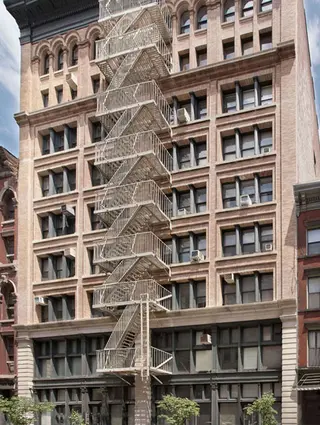 Carter Horsley
Carter HorsleyJan 24, 2020
Carter's Review
This very handsome, 9-story, pre-war apartment building at 45 Lispenard Street between Broadway and Church Street in the TriBeCa East Historic District was erected in 1895 and converted to a co-operative in 1979. It has 16 apartments.
It was designed by Cady, Berg & See for Clarence L. Smith in the Renaissance Revival style and was known as the Jewelers' Craft Building. It replaced five masonry dwellings, some of which had been occupied by a manufacturer of cloth hats and caps and a merchant of artificial flowers.
The historic occupants included Wigger & Swayze, woolens and linens; S. Hollander, ribbons and yarns; G. Merzbach, furnishing goods; and merchants of cloth and clothing.
During the mid-20th Century, the building acquired the name "Jewelers' Craft Building." It was used for storage and light manufacturer until the upper stories were converted in 1979-80 into joint living and working spaces for artists. The architect for the residential conversion for Peter Nelson was Thomas Rochon.
The street is named for Anthony Lispenard, who immigrated from France in the 18th Century and the area was once known as Lispenard Meadows. The street is only one block long and is wider at Church Street than at Broadway. It is one block south of Canal Street and not far from subway stations.
Bottom Line
An important and imposing mid-block building in the Renaissance Revival style in the TriBeCa East Historic District. It was designed by Cady, Berg & See, whose other buildings in the city include the old Metropolitan Opera House, parts of the complex of the American Museum of Natural History and additions to the Presbyterian Hospital.
Description
The building has a two-story base with three rusticated columns dividing the black cast-iron windows, a five-story midsection and a two-story crown. The base, which is surmounted by a wide bandcourse, has coursed stone piers and a simple entablature and classically inspired cast-iron storefront pilasters. The midsection has simple brick piers framed the bays and cast-iron engaged columns between the windows which are contained in framed beige masonry. There is another wide bandcourse above the seventh floor. At the crown, brick pilasters support decorative arches and a metal terminal cornice.
The historic district's designation report noted that "Additional surviving historic fabric includes wood-framed show windows, doors and transoms at the ground story, many fixed frame and pivoting wood windows at the second story, and double-hung wood windows and an iron fire escape at the upper stories."
The building's base has a slightly raised metal-and-glass front landing with several railed entrances.
Amenities
The building has a roof deck with a Viking grill and an outdoor showers, and a virtual doorman. Pets are allowed.
Apartments
Many of the apartments have barrel vaulted ceilings and columns.
Apartment 2W is a one-bedroom unit that has a 43-foot-wide living/dining room and a 15-foot-wide open kitchen with an island and a 14-foot-wide library.
Apartment 5E is a two-bedroom unit with a 9-foot-long entry foyer that leads past an open, 14-foot-wide kitchen with an island to a 26-foot-wide living room, a 12-foot-wide dining area and an 11-foot-wide library.

- Co-op built in 1920
- Converted in 1979
- 1 apartment currently for sale ($3M)
- Located in Tribeca
- 16 total apartments 16 total apartments
- 10 recent sales ($2.2M to $3.7M)

 6sqft delivers the latest on real estate, architecture, and design, straight from New York City.
6sqft delivers the latest on real estate, architecture, and design, straight from New York City.
